14 Red Birds of Texas
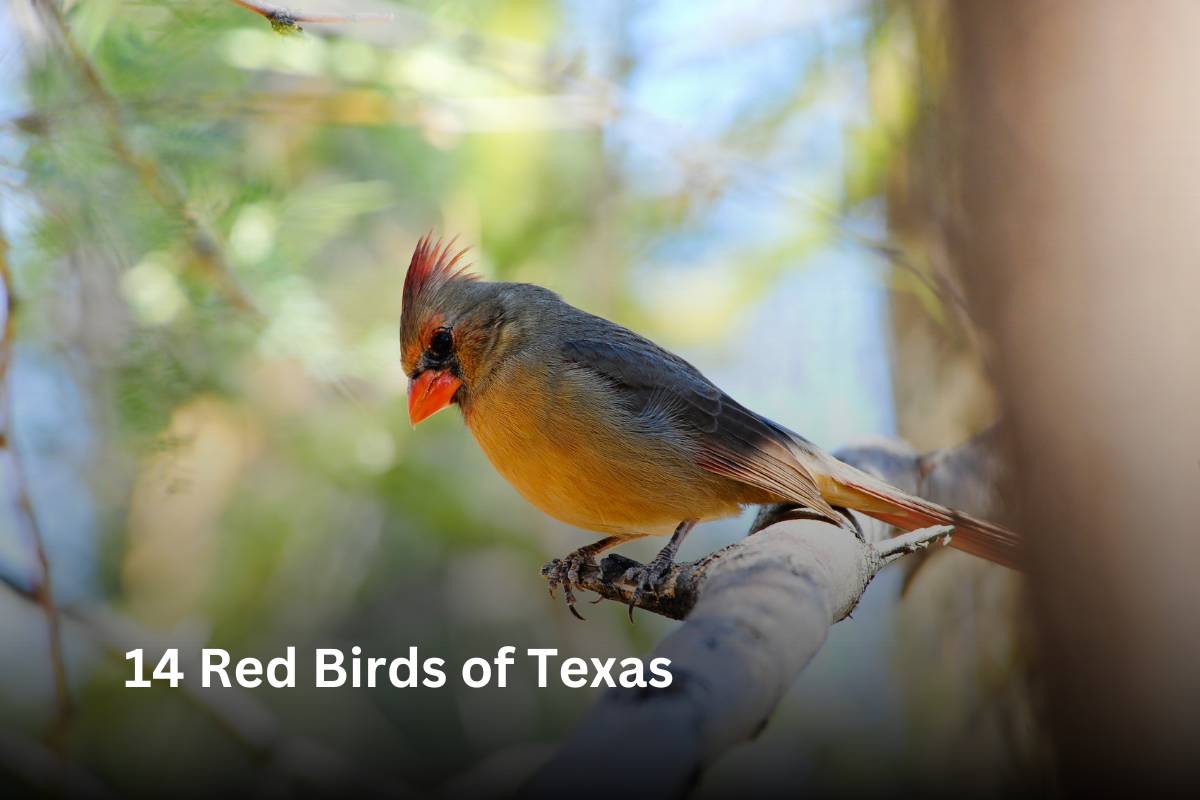
Texas is home to 664 species of birds that are found in the United States, as mentioned by the Texas Bird Records Committee (TBRC). It is well-known for its remarkable diversity of bird species.
From the common redpoll to the Rufous Hummingbird, each species of bird has displayed their physical traits, habitat, behavior, and feeding habits. Texas is one of the top birdwatching destinations in the United States.
Have you ever wondered which red birds frequently visit your yards or gardens? So, today in the following article, we will be talking about the top 14 red birds that are commonly found in the state of Texas.
List of 14 Red Birds of Texas
- Common redpoll (Acanthis flammea)
- Vermilion flycatcher (Pyrocephalus obscurus)
- Two-barred Crossbill (Loxia leucoptera)
- Purple finch (Haemorhous purpureus)
- Ruby-throated hummingbird (Archilochus colubris)
- Pileated woodpecker (Dryocopus pileatus)
- Red-naped sapsucker (Sphyrapicus nuchalis)
- Pyrrhuloxia (Cardinalis sinuatus)
- Red-bellied Woodpecker (Melanerpes carolinus)
- Red-tailed hawk (Buteo jamaicensis)
- Scarlet Ibis (Eudocimus ruber)
- Cinnamon teal (Spatula cyanoptera)
- Red Headed woodpecker (Melanerpes erythrocephalus)
- Rufous Hummingbird (Selassphorus rufus)
1. Common Redpoll (Acanthis flammea)
The common redpoll is also known as the mealy redpoll. It is a small bird species with a bright red patch on its forehead. It is a partial migrant bird. They also have a short conical yellow bill.
This small finch has brownish-grey that contrasts with dark streaks on its flanks and upper body. Both male and female redpoll have a streaking appearance on under tail coverts.
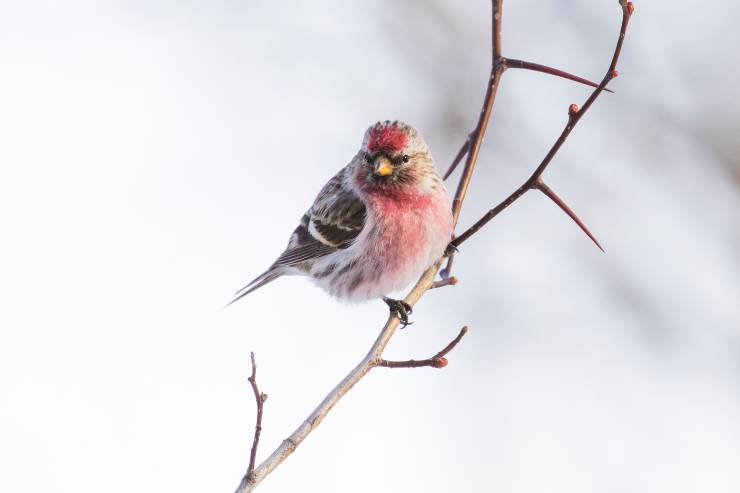
Size, Weight, Wingspan, Lifespan, and Breeding Period of Common Redpoll:
- Size: 4.5 and 5.5 inches (11.5 and 14 cm)
- Weight: 0.42 and 0.56 ounces (12 and 16 grams)
- Wingspan: 19 to 22 cm (7.5 to 8.7 inches)
- Lifespan: two to three years
- Breeding Period: late April to June
As per the IUCN Red List, the common redpoll bird is listed as a species of the least concern. However, the population size of this bird is decreasing significantly.
The common redpoll life span is expected to live for two to three years.
Habitat: Worldwidely, the species of common redpoll can be found in the far northern latitudes. They often breed in open woodlands of pine, spruce, alder, birch, and willow up to 5,000 feet elevation.
In like manner, these birds can also be observed in the town areas. It has extended its breeding range through northern Europe and Asia to northern North America, Greenland, and Iceland.
Feeding: The common redpoll diet consists of seeds and other vegetative matter throughout the year.
It also feeds on small conifer seeds, buds of willows, alders, catkins, and various types of weeds and grasses. During the summer season, it also eats insects.
2. Vermilion Flycatcher (Pyrocephalus obscurus)
The Vermilion Flycatcher is a small passerine bird that belongs to the family of Tyrannidae. This little bird has a striking presence, except among the drab Tyrannidae mainly due to its vermilion-red coloration.
The male Vermilion Flycatcher has a bright red that contrasts with dark brown plumage. Besides this, they also have a short tail, red crown, red chest, and red underparts.
While the female Vermilion Flycatcher is compact. Overall, its appearance is brownish above with a white breast. It also has a peach-colored belly with a dark gray upperside.
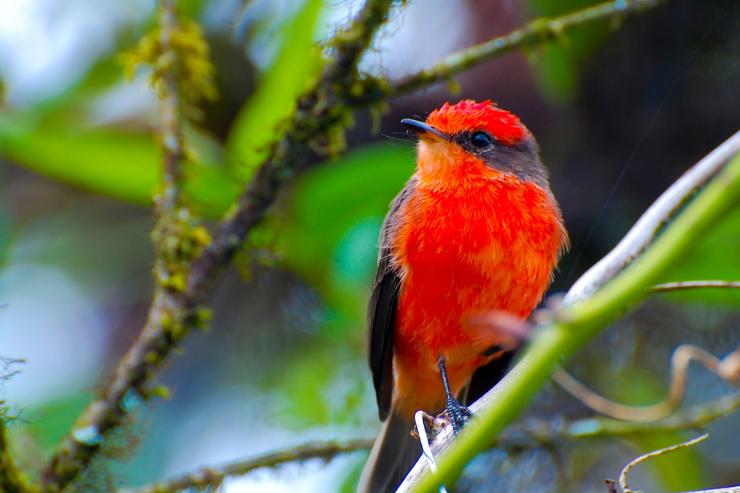
The immature flycatchers are also similar to female birds. The coloration may vary according to the time displaying vermilion, scarlet, or orangish.
Size, Weight, Wingspan, Lifespan, and Breeding Period of Vermilion Flycatcher:
- Size: 13 to 14 cm (5.1 to 5.5 inches)
- Wingspan: 24 to 25 cm (9.4 to 9.8 inches)
- Weight: 11 and 14 g (0.39 and 0.49 oz)
- Lifespan: four years and six months
- Breeding Period: March to July (In the North) and October to January (In the South)
The oldest male Vermilion Flycatcher was recorded to live for at least four years and six months old in Mexico. The average life expectancy of the Vermilion Flycatchers is nearly four years and six months.
According to the IUCN Red List, the conservation status of the Vermilion Flycatchers is classified as a vulnerable species, as of 2022.
Habitat: The Vermilion Flycatcher breeding habitat ranges from Mexico and extends north into the southwestern United States to scattered portions of Central America.
They can be found throughout the open country, including arid scrublands, deserts, trees or shrubs in savanna, scrub, farmlands, canyon mouths, and parks.
Feeding: This species of birds mainly feeds on insects such as grasshoppers, flies, and beetles. It is an opportunistic feeder that usually forages the bees.
This bird catches insects on the wing by flying out from an exposed perch and is occasionally caught on the ground.
3. Two-barred Crossbill (Loxia leucoptera)
Commonly, the two-barred crossbill is also known as the white-winged crossbill. It is a small passerine bird. The adult male has a bright red forehead, crown, nape, and upper parts with a contrast of a black tail and wings.
Female finches are stocky with a crisscrossed bill. They have a yellow-greenish head and upperparts. It also has two bold white wing bars.
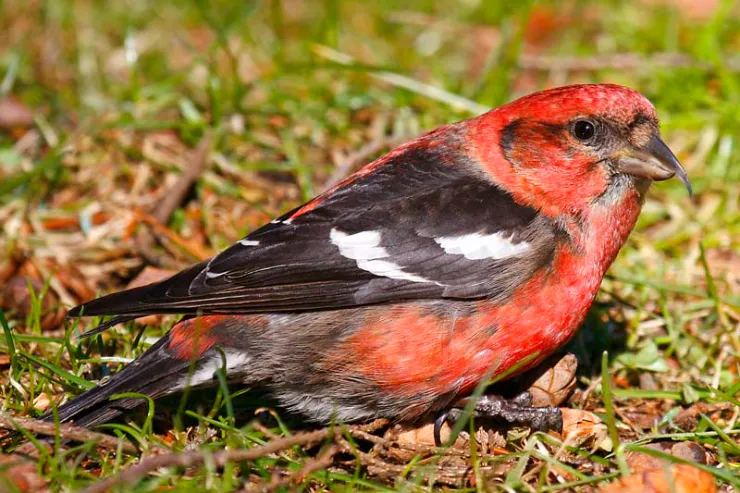
Size, Weight, Wingspan, Lifespan, and Breeding Period of Two-barred Crossbill:
- Size: 14.5 to 17 cm (5.7 to 6.7 inches)
- Weight: 25 to 40 g (0.88 to 1.41 ounces)
- Wingspan: 10.2 to 11.0 in (26 to 28 cm)
- Breeding Period: August to May
As per the IUCN Red List, the two-barred crossbill conservation status is listed as a species of least concern.
Habitat: Their breeding habitat is mainly found in the coniferous forests of Alaska, Canada, and the northernmost United States. Now, they have extended their breeding range from across the Palearctic to northeast Europe.
Feeding: The two-barred crossbill is known to be a specialist feeder on conifer cones. It has an unusual bill shape that helps them to assist in the extraction of the seeds from the cone.
4. Purple Finch (Haemorhous purpureus)
The purple finch is a small bird in the finch family, Fringillidae. These birds have a short forked brown tail and brown wings.
The adult male finch has a raspberry red on the head, breast, back, and foggy white bellies. Similarly, the adult female finch has white underparts with dark brown streaks and light brown upperparts.
This species of bird has a white line on the face just above the eyes. The plumage of both sexes is darker and has a long bill.
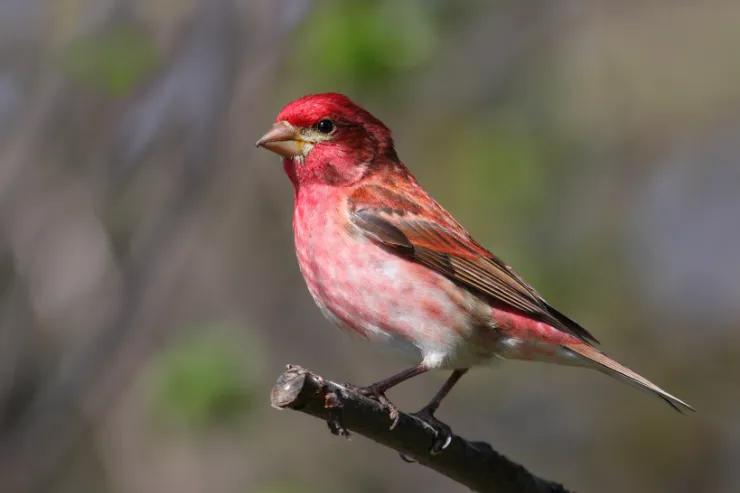
Regarding females, the coloration of this bird is more greenish than that of males.
Size, Weight, Wingspan, Lifespan, and Breeding Period of Purple Finch:
- Size: 12 to 16 cm (4.7 to 6.3 inches)
- Weight: 19.8 to 28.4 g (0.7 to 1.0 ounces)
- Wingspan: 22 to 26 centimeters (8.7 to 10.2 inches)
- Lifespan: three to five years
- Breeding Period: April to August
It has been estimated that the purple finch’s lifespan is about three to five years. As per the IUCN Red List, the conservation status of the purple finch is assessed as a species of least concern.
Habitat: The purple finch breeding habitat occurs in the mixed forests, woods, groves, suburbia, and coniferous forests in Canada and the northeastern United States.
During the winter and migration, they are found in a wide variety of wooded and semi-open environment areas.
Feeding: The purple finch bird is fond of eating sunflower seeds, millet, and thistle. Their main diet consists of seeds, berries, and insects. It forages mainly on the trees and bushes.
5. Ruby-throated hummingbird (Archilochus colubris)
The charismatic ruby-throated hummingbird is a small species of hummingbird. This tiny male hummingbird showcases a metallic green above and grayish white below that contrasts with near-black wings.
It possesses a bright red throat, black mask, and green crown. They have short legs with no knees and also have feet with three toes pointing forward and one backward.

Size, Weight, Wingspan, Bill, Lifespan, and Breeding Period of Ruby-throated hummingbird:
- Size: 2.8-3.5 inches (7-9 cm)
- Wingspan: 3.1 to 4.3 inches (8-11 cm)
- Weight: 2 to 6 g ((0.071 to 0.212 ounces)
- Lifespan: three to five years
- Bill of male: 1.5 to 1.8 cm
- Bill of female: 17 to 21 cm
- Breeding Period: March to July
As per the International Union for Conservation of Nature (IUCN) Red List of Threatened Species, the ruby-throated hummingbird is classified as the least concern for risk of extinction in 2023.
In eastern North America, the population size of this bird is most popular and increasing significantly. However, the other species of this hummingbird in North America are declining significantly.
The ruby-throated hummingbird’s life span is expected to be around three to five years. This breed of hummingbird has the largest breeding range.
Habitat: Its breeding habitat prefers to live in open woodlands, and forest edges like mixed deciduous and broadleaved forests, meadows, parks, orchards, grasslands, and backyards.
Throughout the year in the eastern United States and southeastern Canada, they can be found. It is a migratory hummingbird that often migrates to Eastern North America, Mexico, and Florida during the winter season.
Feeding: In the adult stage, their main diet of food includes small arthropods, nectar from the flowers and flowering trees. From such foods, it takes some part of protein, minerals, and vitamins.
Occasionally, its diet consists of sugar-rich tree sap that is extracted from sapsucker wells. By using their long, extendable tongue it sucks the nectar from flowers and often catches the insects on the wing or by gleaning.
6. Pileated woodpecker (Dryocopus pileatus)
The pileated woodpecker is a large-sized bird that is a common native to North America. In North America, this bird is considered one of the largest confirmed extant woodpecker species.
Both male and female woodpeckers can be easily identifiable. The male woodpecker encompasses a bright red crest and a red stripe on the cheek.
It also has a red line that extends from the bill to the throat. Whereas, the female birds lack the red stripes on the cheek.

Size, Weight, Wingspan, Bill, Lifespan, and Breeding Period of Pileated Woodpecker:
- Size: 40 to 49 cm (16 to 19 inches)
- Weight: 225 to 400 g (7.9 to 14.1 ounces)
- Wingspan: 66 to 75 cm (26 to 30 inches)
- Bill: 4.1 to 6.0 cm (1.6 to 2.4 inches)
- Lifespan: 12 years
- Breeding Period: May to June
The average lifespan of the pileated woodpecker is around 12 years. During banding operations in Maryland, the oldest male pileated woodpecker was found. It was recorded that it had lived for at least 12 years and 11 months old.
According to the IUCN Red List, the conservation status of the pileated woodpecker is assessed as a species of least concern.
This enchanting bird is not considered a threatened species or endangered due to its wide range and large population size.
Habitat: The pileated woodpecker breeding habitat is found in mature forest areas and heavily wooded parks. It can be easily spotted in the eastern United States, the Pacific Coast, Canada, North America, and the Great Lakes.
Every year on an average of 1.5%, the population of pileated woodpeckers has increased significantly.
Feeding: This species of bird is an insectivore that mainly consumes insects. In like manner, the pileated woodpecker also eats their main primary foods.
Such as wood-boring beetle larvae, spruce budworms, termites, other bugs, carpenter ants, cockroaches, and grasshoppers.
7. Red-naped sapsucker (Sphyrapicus nuchalis)
The red-naped sapsucker is a medium-sized bird belonging to the family of Picidae. Adult sapsucker birds have a black head with a red forehead and a small red spot on the nape.
Along with that, it also has white stripes, a yellow breast, a yellow upper belly, a white lower belly, and a rump. Similarly, the female bird has a small white chin patch under the bill.
However, the females have a red throat in the lower part and white in the upper parts. But, the male birds have a red throat patch. The red-naped sapsucker’s lifespan is expected to be two to three years.
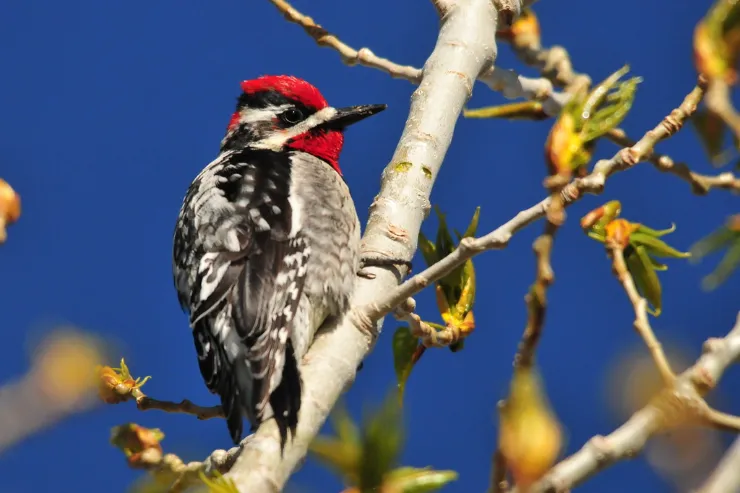
Size, Weight, Wingspan, and Lifespan of Red-naped Sapsucker:
- Size: 7.5 to 8.3 inches (19 to 21 cm)
- Weight: 1.1 to 2.3 ounces (32 to 66 g)
- Wingspan: 41 to 43 cm (16.1 to 16.9 inches)
- Lifespan: two to three years
- Breeding Period: April to July
Habitat: Primarily, their breeding habitat resides in the mixed forests in the Rocky Mountains, and Great Basin, especially around aspens.
The red bird build their nest cavity mostly in the dead trees. Sometimes, during the breeding season, they often reuse their nests.
Feeding: These species of birds are true to their name. They eat seeds and berries. On the other hand, the red-naped sapsucker also catches insects in flight. It drills the holes in trees and eats the sap and insects from it like other sapsuckers.
8. Pyrrhuloxia (Cardinalis sinuatus)
The pyrrhuloxia is a medium-sized red bird commonly found in the American southwest and northern Mexico. This bird is also known as the desert cardinal.
It is a stocky songbird with a short, stout bill, red crest, and wings. The desert cardinal closely resembles the northern cardinal and vermilion cardinal bird.
The adult male has a short and heavy seed-cracking yellow bill. Similarly, the adult female has a grayish overall with red highlights on the wings, crest, and tail.
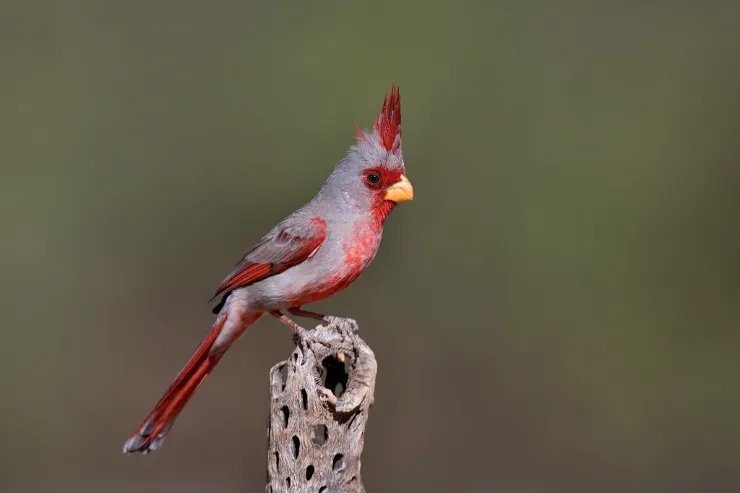
The immature cardinal looks like a female with a distinctive dark bill and few red highlights on the overall body parts.
Size, Weight, Lifespan, and Breeding Period of Pyrrhuloxia:
- Size: 21 cm (8.3 inches)
- Weight: 0.8 to 1.5 ounces (24 to 43 g)
- Lifespan: Up to nine years
- Breeding Period: mid-March to mid-August
The conservation status of pyrrhuloxia is classified as a species of least concern. However, research was conducted to survey the population of this cardinal.
It resulted that there is a slight decline in this species of cardinals. The average lifespan of the pyrrhuloxia is expected to be up to nine years.
In the winter season, it often migrates in huge flocks which are easily visible to most of the bird feeders. This species of cardinal is a benefit to cotton fields that helps to eat large populations of cotton worms and weevils.
Habitat: Throughout the year, this bird is resident in the United States of Arizona, Texas, and New Mexico. They can be found in the desert scrub and mesquite thickets.
Relatively, the pyrrhuloxia is a non-migratory bird whose breeding habitat ranges from the west to east coast of Mexico.
Feeding: The pyrrhuloxia diet consists of seeds, insects, and fruits. This cardinal also forages on the trees to snatch the insects. Besides this, it also picks the seeds from the plants and stalks of grasses.
9. Red-bellied Woodpecker (Melanerpes carolinus)
The red-bellied woodpecker is a medium-sized woodpecker belonging to the family of Picidae. This bird has earned its name as red-bellied from its unique appearance of the pale reddish blush on its lower parts.
The female adult has a red patch on the nape and above its bill. It also has a black and white barred woodpecker with a pale reddish tinge on the belly. But, the female woodpecker lacks the red crown.
While the adult male also resembles similar to the adult female. But, this male woodpecker has a red crown, red nape, and light gray on the face and underparts of its body.
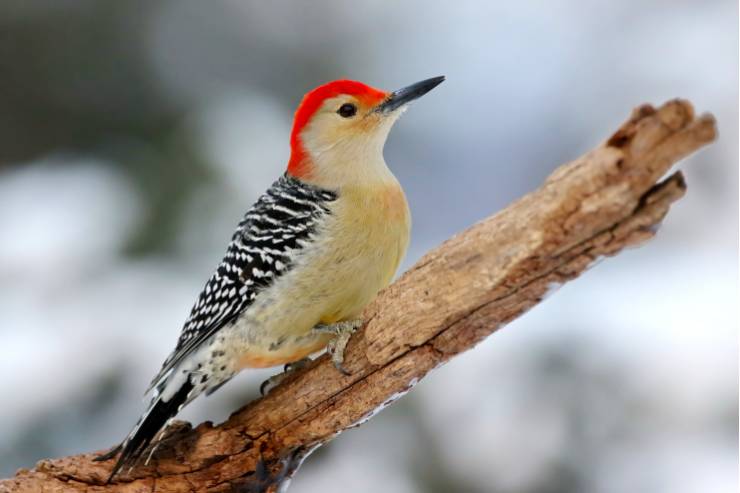
Size, Weight, Wingspan, Lifespan, and Breeding Period of Red-billed Woodpecker:
- Size: 9.00 to 10.51 inches (22.85 to 26.7 cm)
- Weight: 57 to 91 g (2.0 to 3.2 ounces)
- Wingspan: 15 to 18 inches (38 to 46 cm)
- Lifespan: 12 years
- Breeding Period: January to February
In Georgia, the oldest male red-bellied woodpecker was found whose age was recorded to be at least 12 years and three months old. The average lifespan of this bird is expected to be 12 years.
As of now, the conservation status of this bird is not listed as a threatened or endangered species by the IUCN Red List. Overall, the population of the red-bellied woodpecker is increasing slightly.
Habitat: This lovely bird mainly breeds in the eastern United States and ranges from South Florida to northern Canada. They are a common year-round resident throughout eastern Texas.
Moreover, it prefers to inhabit deciduous forests near rivers, streams, swamps, or wooded suburban habitats.
Feeding: The red-bellied woodpecker displays the behavior of foraging by catching or storing food. With the use of its bill, this bird cracks on trunks of trees or drills into the bark.
A survey was conducted by some bird ornithologists, then it showed that the red-bellied woodpecker spent 20% to 69% of its time on foraging. They are omnivores. Its main diet consists of insects, fruits, nuts, and seeds.
10. Red-tailed hawk (Buteo jamaicensis)
The red-tailed hawk is a large species of hawk belonging to the family of Accipitridae. In the United States, it is regarded as one of the three species colloquially known as the “chickenhawk”.
According to the range and its appearance, the red-tailed hawk is classified into 14 sub-species. On the other hand, it is also known as the red-tail for short.
The adult red-tails have a brown nape and upper head with a white throat. Most of its lower parts are pale with a darker belly band and wing tips.
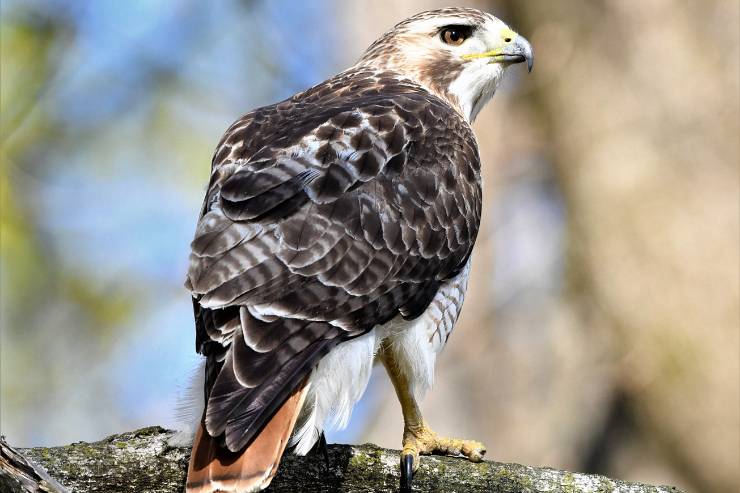
These hawks have a rally, the adult hawk has rufous-toned upper parts with extensive white spangling and a white tail. It forms a variable imperfect “V” on the back.
While the immature red-tailed hawks have a light brown tail in the above parts. Relatively, its bill is short and dark in the hooked shape of a raptor. The red-tailed hawk’s legs, core, and feet are yellow.
Size, Weight, Wingspan, Lifespan, and Breeding Period of Male Red-tailed Hawk:
- Size: 18 to 24 inches (45 to 60 cm)
- Weight: 1.52 to 2.87 lbs (690 to 1,300 g)
- Wingspan: 3 ft 5 in to 4 ft 8 inches (105 to 141 cm)
- Lifespan: Upto 20 years
- Breeding Period: March to May
Size, Weight, Wingspan, and Lifespan of Female Red-tailed Hawk:
- Size: 19 to 26 inches (48 to 65 cm)
- Weight: 1.766 to 3.799 lbs (801 to 1,723 g)
- Wingspan: 4 ft 10 inches (147 cm)
According to the IUCN Conservation Status, the red-tailed hawk is classified as the least concern. However, the population of this hawk is increasing significantly.
The average lifespan of the red-tailed hawk is up to 20 years. In 2011, the oldest wild Red-tailed Hawk was found in Michigan that recorded to be 30 years and eight months old.
Habitat: It mostly prefers to live in mixed forests, fields, and large wooded edges, near coastal or wetlands, deserts, tropical rainforests, foothills, urban areas, and deciduous woodlands.
The red-tailed hawk is one of the largest breeding range hawks in the north of the Mexican border. Besides this, it also breeds from north-central Alaska, Texas, northern Canada, Georgia, North America, and southern Canada.
Feeding: It is a highly opportunistic feeder that eats other animals, called carnivores. Commonly, their prey consists of small mammals, especially rodents and lagomorphs.
Apart from all of this, the red-tailed hawk also consumes birds, reptiles, fish, invertebrates, and amphibians.
11. Scarlet Ibis (Eudocimus ruber)
Commonly, the scarlet ibis bird is also known as the red ibis. It is a sociable and gregarious bird. The scarlet ibis is the national bird of Trinidad and Tobago and Tupi-Guarani.
This wadering bird is a hardy, numerous, and prolific bird. The scarlet ibis is only the shorebird with red coloration in the world of avian diversity. The adult ibis have red bills and feet.
Likewise, they have a long, narrow, and decurved bill. Its bill is blackish towards the end. The bird coloration shows vivid pink to reddish pink plumages.
While the juveniles are a mix of grey, brown, and white. This elegant bird moves as a flock by forming a V formation.
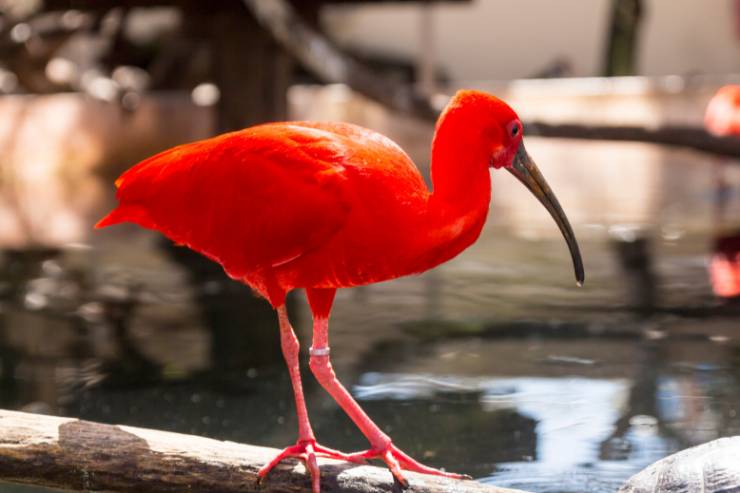
Size, Weight, Wingspan, Lifespan, and Breeding Period of Scarlet Ibis:
- Size: 22–25 inches (55-63 cm)
- Weight: 3.1 lbs (1.4 kg)
- Wingspan: 21 inches (54 cm)
- Lifespan: 32 years
- Breeding Period: Mid-September to December
The average lifespan of Scarlet Ibis is expected to be 32 years. In the wild, this bird lives for 16 years in its natural environment. Similarly, in captivity, the stunning red bird can live up to 20 years.
As per the International Union for Conservation of Nature (IUCN Red List), the scarlet ibis has been classified as a species of least concern.
Habitat: It is a medium-sized bird that is mainly found in wetlands, marshy habitats, shorelines, and rainforests.
They often migrate in flocks of large colonies in the coastal areas of the states of Rio de Janeiro, Parana, Santa Catarina, Brazil, Guyana, Suriname, and Venezuela.
Feeding: With the help of their distinctive long, thin bills, the scarlet ibis uses it to probe the food from under plants or soft mud. They feed on shrimp, scarabs, ground beetles, water beetles, fish, water bugs, and crustaceans.
When this bird consumes a large quantity of shrimp and other red shellfish then it produces astaxanthin, a keto-carotenoid in their body. This key component produces red pigmentation.
12. Cinnamon teal (Spatula cyanoptera)
The cinnamon teal is a small species of duck that belongs to the family of Anatidae. The adult male has a cinnamon-red head and body which is covered with a brown back. It also has a red eye and a dark bill.
However, the plumage of female birds is dull brown in comparison to the male having bright reddish plumage. The adult female teal bird has a grey bill. This species of bird resembles the female blue-winged teal.
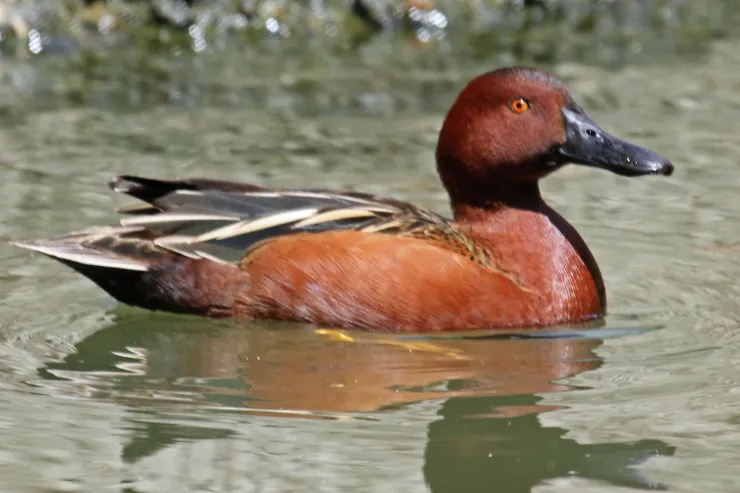
Size, Weight, Wingspan, Lifespan, and Breeding Period of Cinnamon Teal:
- Size: 41 cm (16 inches)
- Wingspan: 56 cm (22 inches)
- Weight: 400 g (14 ounces)
- Lifespan: 10 to 17 years
- Breeding Period: mid-May to mid-June
The cinnamon teal lifespan is expected to be between 10 to 17 years. However, in the wild, they can live up to 10 years and in captivity for about 20 years.
The oldest Cinnamon Teal was a female and was found in California in 2010. It recorded its age to be at least 10 years and six months old. Throughout its wide range, the Cinnamon Teal is not considered endangered.
Habitat: It is a migratory bird and its breeding habitat occurs in the ponds and marshes of the Western United States and extremely on the southwestern Canada.
Feeding: Primarily, their main diet includes mollusks and aquatic plants. Being a species of duck it feeds its food by dabbling. It also eats plants.
13. Red-headed woodpecker (Melanerpes erythrocephalus)
The red-headed woodpecker is a mid-sized that belongs to the family of Picidae. Adult male woodpeckers have a large redhead, a big chisel-like bill, white underparts, and black backs with prominent patches on the wings.
While the juveniles have a brown head, blackish brown back, and dingy belly. The red-headed woodpecker is often confused with the red-bellied woodpecker. It is mainly due to its size and the vibrant orange-red crown and nape.
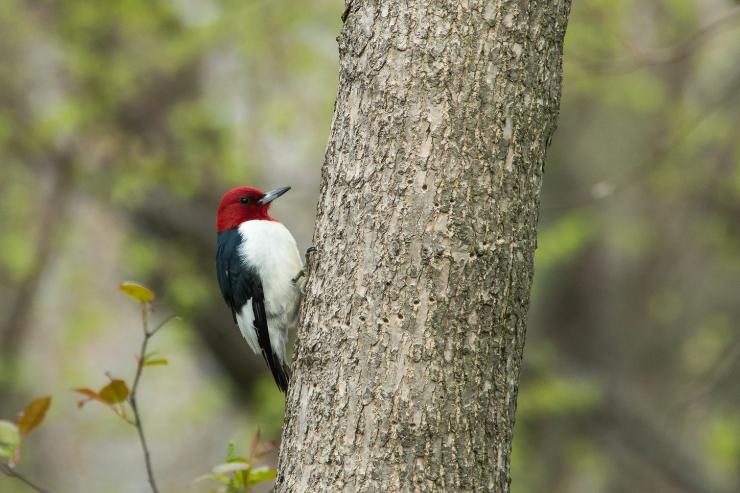
Size, Weight, Wingspan, Bill, Lifespan, and Breeding Period of Red-headed Woodpecker:
- Size: 7.5 to 9.8 inches (19 to 25 cm)
- Weight: 2.0 to 3.4 oz (56 to 97 g)
- Wingspan: 16.7 inches (42.5 cm)
- Bill: 0.83 to 1.18 inches (2.1–3 cm)
- Lifespan: 119 months
- Breeding Period: Between April and July
As of the latest data, the IUCN Red List has classified the red-headed woodpecker as a species of the least concern. In the wild, the life span of this bird is nine years and nine months.
Its maximum lifetime range is predicted to be 12 years. It has been found that the oldest red-headed woodpecker had lived for at least nine years and eleven months.
Habitat: This bird is native to North America. Red-headed Woodpeckers live in open pine woods, forest peripheries, orchards, and tall tree woodlands.
Feeding: This species of bird is omnivorous. Mostly, their primary source of food is from seeds, fruits, berries, nuts, insects, and small rodents.
While 2/3rd of their diet consists of plant materials. It has a unique feature that keeps food caches.
Throughout the year, they keep themselves feeding by stuffing their food under tree bark, crevices, and tree cavities.
14. Rufous Hummingbird (Selassphorus rufus)
It is a small-sized hummingbird. The rufous hummingbird is better known for its extraordinary flight skills. This bird has a long straight and slender bill which measures about 3.1 inches or 8 cm long.
The adult male hummingbird has a rufous face with an iridescent orange-red throat patch or gorget. Including that, they also have a white breast and their back is somewhat green.
The female hummingbirds have orange feathers in the center of the throat with white tips and reddish-brown faces. Overall, the females are slightly larger as compared to the males.
The average lifespan of this bird is nearly three to five years. It is quite hard to identify the rufous hummingbird from the Allen’s hummingbird.
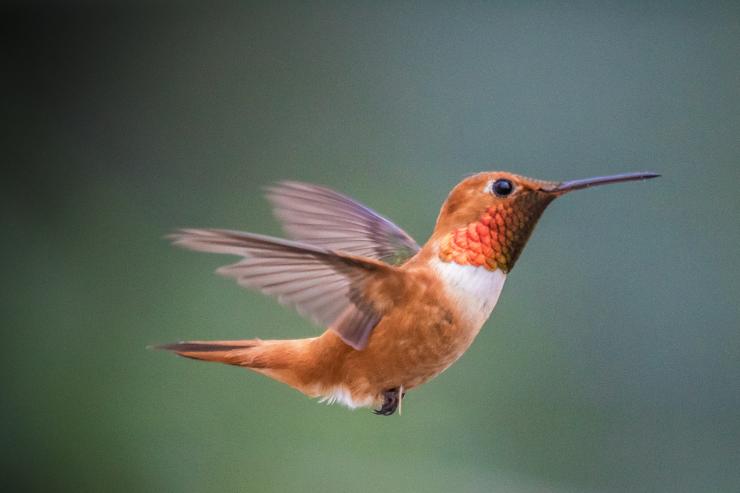
Size, Weight, Wingspan, Lifespan, and Breeding Period of Rufous Hummingbird:
- Size: 2.8 to 3.5 inches (7 to 9 cm)
- Weight: 0.071 to 0.176 ounces (2 to 5 g)
- Wingspan: 4.3 inches (11 cm)
- Lifespan: three to five years
- Breeding Period: April to July
The average life span of the rufous hummingbird is three to five years. However, the oldest male rufous hummingbird was found to live for at least eight years and eleven months.
Later on, it was rereleased during the banding operations in British Columbia in 2004. According to the IUCN Red List, the rufous hummingbird was listed as least concern in the year 2018.
Thereafter, this bird was uplifted to near-threatened species on the IUCN Red List.
Habitat: These breeding birds are found in shrubby areas, yards, swamps, forests, parks, and meadows.
Primarily, it lives in the eastern United States, western United States, that includes Texas and Alaska. From May to September, rufous resides in the lowlands to take certain advantage of the wildflower season.
Feeding: Their diet consists of nectar from a variety of flowers. These small hummingbirds use their long extendable tongue to catch insects. It can also catch the insects with the help of its wings.
The rufous hummingbird is a vulnerable bird known for eating birds and animals. During the daytime, they actively feed whereas, at night, they conserve their energy by becoming torpid.
Conclusion
In conclusion, Texas, the United States includes a wide variety of red-hued birds, each of them possessing their unique appearance, soothing calls, and songs to its rich avian tapestry.
These fascinating red birds have not only enhanced the beauty of the state, of Texas but have also played a crucial role in the ecosystem.
Their unique presence has added the beauty of the rich biodiversity. It has also helped to understand the importance of the protection and conservation efforts of the vibrant species of red birds.






